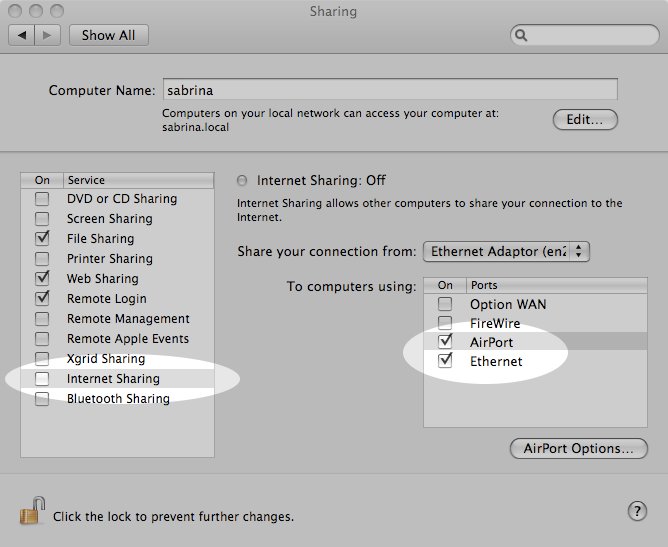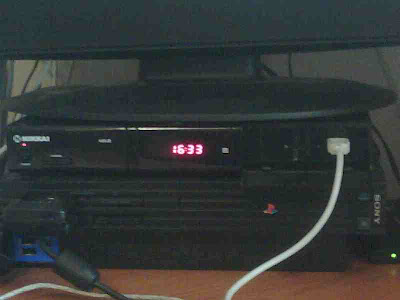Tuesday, February 02, 2010
Merging blogs
The new combined blog is now online at http://blog.retep.org/
Saturday, July 11, 2009
Turn your Mac into a Wifi Base Station
Some people like myself use mobile broadband for their internet connection, either because it’s the only option where they live or like me have had enough of BT (in the UK you usually still need BT for the physical line regardless of the ISP).
Now with the various dongles they work fine on the the local machine and for the local wired network its usually as simple as turning on Internet Sharing (for the 3 network you have to do things differently due to them using a special profile). The problem comes to when you want to share the connection via wifi - but don’t have a wifi router.
On Linux boxes some wifi chipsets support base station mode but things become complicated due to having to configure the card, the firmware etcetera... but what about on a Mac? All recent Mac’s have AirPort cards so can a Mac act as a base station?
To put it simply, yes and it’s supported as standard (I’m using OSX10.5.7). Not only that it can be enabled from a couple of extra clicks.
First open System Preferences and select Sharing:

Next Select (not check) Internet Sharing and make sure AirPort is turned on (I also have Ethernet enabled as well).

Now at this point when you turn on sharing the WiFi connection will be open to anyone - so it’s probably advisable to turn on encryption by Selecting AirPort Options:
That’s all there is to it. You simply turn it on by turning Internet Sharing on and pressing start.

Saturday, February 28, 2009
Nikkai A88JB FreeView PVR
Maplin currently have some special offers on at the moment and one of them is the Nikkai A88JB USB PVR Digital TV Receiver for £39.99. Now I wasn’t really in the market for a new receiver but what caught my eye was that, unlike other standalone Freeview boxes with a card slot or usb port, this one supposedly records onto an external HD connected to the USB port - so I thought I’d give it a try.
First the manual - what crap. It looks like it’s a photocopy of some original written in the usual pigeon english you’d expect of something mass made in China.
As for the unit, it doesn’t look that well built with three buttons on the front (Power, Channel Up and Down) and a display showing the time when in standby or the channel number. On the right hand side there’s a cover which when opened shows the SD/MMC slot and the USB port.

View of the unit sitting on top of my old PS2.
The white cable is plugged in to the USB port and connects an old USB Harddrive to the unit.
Once plugged in it runs relatively well. Scanning for channels is quick and when in use it’s a lot more responsive than my existing Freeview box (built into the TV).(a lot quicker than the one I’ve been using) and the user interface is not the best I’ve seen - I’ve seen better with units far cheaper than this one, but at least it works.Now apparently it has text support but I can’t get that to work, and you cannot record radio (no big deal there), but the main thing is the recording of programs.
Recording live TV is simple, just press REC and it records. To stop you’d have thought you would press the stop button next to it but no, it’s press REC again then confirm by pressing left and Enter - 3 button presses when there’s a button next to it!
Playback from the unit appears fine as well, but the timer is sheer crap. You can only program in up to 8 timers and you can set them with the date, time and channel and if it occurs once, every day, week or year (why?). It takes me back to programming VHS recorders twenty years ago.
So, now begs the question - can the recordings be played back on the Mac?
Well, the files are stored on the HD as .mpg files and they are readable. However Quicktime doesn’t recognise it (this is with Perian installed). Not looking good so far. I then tried Media Player 10 that I have installed inside VMWare and again no go. Media Player plays the audio but could not find a video codec.
Not wanting to give up on 40 quid I then turned to good old Open Source.
So I fired up VideoLan and tried playing the recorded program - presto it works.

A test recording being played with VLC on Mac OSX10.5
Now if VideoLan works on the Mac then will it work with Linux? Yep even on Linux it will play a recording :-)

A test recording being played with VLC running on Ubuntu 8.10
So all in all it seems that it might be a decent unit. The timers could do with some work, and it looks ugly with the USB cable showing from the front (no rear USB port), but it might be a good buy - we’ll see.
I’m going to set it up to record some shows during the next week (ones on whilst I’m at work) and see how it performs, so expect an update next week.
Thursday, February 12, 2009
Connecting to both local lan and 3's 3G Dongle on the Mac
A problem reported elsewhere on the net with 3’s 3G Broadband dongles is that while you are connected to the net it disconnects you from your local lan preventing you from accessing both. I presume its to prevent people from sharing the broadband without using their dedicated router which they sell to connect the dongle direct to the lan.
Anyhow the main problem for me is that when using a VPN with the dongle, the Mac could connect to the remote network fine, but Windows or Linux running inside VMWare could not as the dongle broke the network. This was causing me problems as I need to access MSSQL on the odd occasion.
Anyhow I’ve managed to figure out a way to allow the local lan to be connected at the same time with the dongle. In fact it’s so simple it’s stupid and I’m surprised no one has documented this anywhere else online - at least I never found it and various forums I’ve seen this question on don’t have this solution.
The trick is:
- Connect to the net
- Open System Preferences and click on Network
- You should see 3Connect in the Location dropdown - if not make sure it’s visible
- On the left you should see the list of interfaces (Ethernet, Bluetooth etc) all greyed out.
- Click on the + at the bottom left corner of that list and a popup appears.
- Select Ethernet in the Interface dropdown then press Create
- Now if you use DHCP like I do thats it - DHCP will kick in within a few seconds.
- If you don’t use DHCP then simply configure the new interface with a local static IP.
That’s it - nice and simple. Your milage may vary with this, but at least it worked for me.
Here’s the screenshot where you can see Ethernet 2 connected and the Dongle (disconnected when I took this screenshot):

Sunday, January 04, 2009
How to change the Blue Screen of Death into another colour
- 0 - Black
- 1 - Blue
- 2 - Green
- 3 - Cyan
- 4 - Red
- 5 - Magenta
- 6 - Yellow
- 7 - White
- 8 - Grey
- 9 - Bright blue
- A - Bright green
- B - Bright cyan
- C - Bright red
- D - Bright magenta
- E - Bright yellow
- F - Bright white
Monday, December 29, 2008
Sets and Nodes with PostgreSQL
At times you need to be able gather information into Sets where an entry can contain one or more entries or sets, or Nodes where an entry has child nodes each of whom can contain their own children. For me it’s usually a geographical tree (Continent, Country, County, Town) or permission roles (Administrator, Moderator, User). Although this is documented elsewhere on the net, here’s how I do this in PostgreSQL utilising pl/pgsql functions.
The tree of nodes consists of one entry in the table per node, with the root node at the top of the tree. Selects on the table are fast, but updates are expensive. As the data contained in the tree rarely changes, this is perfectly fine for most purposes.
For the first example, I’m going to use a geographical tree, so we will have at the end of the exercise the following tree:

First we need a table to store the data. The following SQL Schema defines the node table and inserts the root. Apart from this instance, you should only use the pl/pgsql functions to modify this table:
CREATE SEQUENCE nodeseq;
CREATE TABLE node (
nodeid BIGINT NOT NULL,
l BIGINT NOT NULL,
r BIGINT NOT NULL,
d INTEGER NOT NULL, -- the depth of this node, 0 = root
n name NOT NULL,
PRIMARY KEY (nodeid)
);
CREATE INDEX node_l ON node(l);
CREATE INDEX node_r ON node(r);
CREATE INDEX node_lr ON node(l,r);
CREATE INDEX node_lrd ON node(l,r,d);
CREATE INDEX node_ln ON node(l,n);
CREATE INDEX node_rn ON node(r,n);
CREATE INDEX node_lrn ON node(l,r,n);
CREATE INDEX node_lrdn ON node(l,r,d,n);
-- The root node (0) preinitialised for the structure to work.
INSERT INTO node (nodeid,l,r,d,n) VALUES (0,1,2,0,'root');
Here we have the table initialised with the root node. At first it has the nodeid of 0, l=1, r=2 and d=0. Over time the l and r values will change as nodes are added to the tree.
Now for the first set of pl/pgsql functions. This set of functions handle retrieval of nodes from the tree based on certain criteria. I’ll only show the function definitions for now as I’ll show how to use these later in this article.
Retrieving a node by its nodeid
CREATE OR REPLACE FUNCTION node_get( parentid BIGINT )
RETURNS node
AS $$
DECLARE
n node;
BEGIN
SELECT *
INTO n
FROM node
WHERE nodeid=parentid;
IF NOT FOUND THEN
RAISE EXCEPTION 'Node % not found', parentid;
END IF;
RETURN n;
END
$$ LANGUAGE 'plpgsql';
Is the node a leaf, i.e. it contains no children
CREATE OR REPLACE FUNCTION node_isleaf( childnodeid BIGINT )
RETURNS boolean
AS $$
DECLARE
child node;
BEGIN
child := node_get( childnodeid );
RETURN (child.r-child.l)==1;
END
$$ LANGUAGE 'plpgsql';
Does one node contain the other
CREATE OR REPLACE FUNCTION node_contains( parentnodeid BIGINT, childnodeid BIGINT )
RETURNS boolean
AS $$
BEGIN
RETURN node_contains( node_get( parentnodeid ), node_get( childnodeid ) );
END
$$ LANGUAGE 'plpgsql';
CREATE OR REPLACE FUNCTION node_contains( parentnode node, childnode node )
RETURNS boolean
AS $$
BEGIN
RETURN parentnode.l<=childnode.l AND parentnode.r>=childnode.r;
END
$$ LANGUAGE 'plpgsql';
Retrieve the parent of a node
CREATE OR REPLACE FUNCTION node_parent( rootnodeid BIGINT, childnodeid BIGINT )
RETURNS node
AS $$
DECLARE
rootnode node;
startnode node;
parentnode node;
BEGIN
IF childnodeid = rootnodeid THEN
RAISE EXCEPTION 'Node % has no parent', childnodeid;
END IF;
-- get the root
rootnode := node_get( rootnodeid );
-- get the start
startnode := node_get( childnodeid );
-- the root must contain the start
IF NOT node_contains( rootnode, startnode ) THEN
RAISE EXCEPTION 'Node % is not contained by the root node %', childnodeid, rootnodeid;
END IF;
-- The root is the parent
IF rootnode.d = (startnode.d-1) THEN
RETURN rootnode;
END IF;
SELECT *
INTO parentnode
FROM node
WHERE l<startnode.l AND r>startnode.r AND d=startnode.d-1;
IF NOT FOUND THEN
RAISE EXCEPTION 'Node % has no parent', childnodeid;
END IF;
-- the root must contain the parent
IF NOT node_contains( rootnode, parentnode ) THEN
RAISE EXCEPTION 'Node % has no parent', childnodeid;
END IF;
RETURN parentnode;
END
$$ LANGUAGE 'plpgsql';
Add a child node
This is probably the most important function as it adds a new node as a child to another and as such is the primary means of adding nodes to the tree.
CREATE OR REPLACE FUNCTION node_addchild( parentid BIGINT, name NAME )
RETURNS node
AS $$
DECLARE
parent node;
child node;
tmp TEXT[];
BEGIN
-- Validate name ensuring it contains no index
SELECT regexp_matches( name, E'([^\\]]+)(\\[([^\\[]+)\\]){0,1}' )
INTO tmp;
IF tmp[2] IS NOT NULL THEN
RAISE EXCEPTION 'Name % is invalid, it may not contain an index', name;
END IF;
parent := node_get( parentid );
/* We allow same named children, but this would disallow it
SELECT *
INTO child
FROM node
WHERE l > parent.l AND r < parent.r AND n = name;
IF FOUND THEN
RAISE EXCEPTION 'The child % already exists under %', name, parentid;
END IF;
*/
UPDATE node
SET r=r+2
WHERE r >= parent.r;
UPDATE node
SET l=l+2
WHERE l >= parent.r;
INSERT INTO node (nodeid,l,r,d,n)
VALUES (nextval('nodeseq'), parent.r, parent.r+1, parent.d+1, name);
child := node_get( currval('nodeseq') );
RETURN child;
END;
$$ LANGUAGE 'plpgsql';
Now using our example tree, the first thing we need to do is to add Europe to the tree as a child of the root. Now the root always has nodeid 0 so we call node_addchild( 0, ‘Europe’ ) to add a new node representing Europe:
test=# select * from node;
nodeid | l | r | d | n
--------+---+---+---+------
0 | 1 | 2 | 0 | root
(1 row)
test=# select * from node_addchild(0,'Europe');
nodeid | l | r | d | n
--------+---+---+---+--------
1 | 2 | 3 | 1 | Europe
(1 row)
test=# select * from node;
nodeid | l | r | d | n
--------+---+---+---+--------
0 | 1 | 4 | 0 | root
1 | 2 | 3 | 1 | Europe
(2 rows)
Here you’ll notice that after the call to node_addchild() it returned the new node (nodeid 1) and updated the root node so it’s l and r fields bound those of it’s children.
We’ll now add the other nodes except the towns:
test=# select * from node_addchild(1,'United Kingdom');
nodeid | l | r | d | n
--------+---+---+---+----------------
2 | 3 | 4 | 2 | United Kingdom
(1 row)
test=# select * from node_addchild(2,'Kent');
nodeid | l | r | d | n
--------+---+---+---+------
3 | 4 | 5 | 3 | Kent
(1 row)
test=# select * from node_addchild(2,'Sussex');
nodeid | l | r | d | n
--------+---+---+---+--------
4 | 6 | 7 | 3 | Sussex
(1 row)
Adding a node by it’s path
Apart from node_addchild we can also add a node by it’s path. For Canterbury it’s path from Europe is “United Kingdom/Kent/Canterbury” so instead of having to find Kent, we can use the node_addchildbypath function:
test=# select * from node_addchildbypath( 0, 1, 'United Kingdom/Kent/Canterbury' );
nodeid | l | r | d | n
--------+---+---+---+------------
5 | 5 | 6 | 4 | Canterbury
(1 row)
Here’s the node_addchildbypath function:
CREATE OR REPLACE FUNCTION node_addchildbypath( rootnodeid BIGINT, parentid BIGINT, path TEXT )
RETURNS node
AS $$
DECLARE
rootnode node;
parent node;
child node;
tmp TEXT[];
lastname TEXT;
path2 TEXT;
name2 TEXT;
BEGIN
rootnode := node_get( rootnodeid );
parent := node_get( parentid );
IF NOT node_contains( rootnode, parent ) THEN
RAISE EXCEPTION 'Parent % is not contained by root %', parentid, rootnodeid;
END IF;
-- Extract the last path
SELECT regexp_split_to_array( path, E'\\/' )
INTO tmp;
IF array_upper( tmp, 1 ) = 1 THEN
child := node_addchild( parentid, path );
ELSE
-- remove the tail element
name2 := tmp[ array_upper(tmp, 1 ) ];
path2 := substr( path, 0, length(path) - length( name2 ) );
parent := node_findbypath( rootnodeid, parentid, path2 );
child := node_addchild( parent.nodeid, name2 );
END IF;
RETURN child;
END;
$$ LANGUAGE 'plpgsql';
Now we’ll add the last set of towns to the tree:
test=# select * from node_addchildbypath( 0, 1, 'United Kingdom/Kent/Maidstone' );
nodeid | l | r | d | n
--------+---+----+---+-----------
6 | 7 | 8 | 4 | Maidstone
(1 row)
test=# select * from node_addchildbypath( 0, 1, 'United Kingdom/Kent/Tonbridge' );
nodeid | l | r | d | n
--------+----+----+---+-----------
7 | 9 | 10 | 4 | Tonbridge
(1 row)
test=# select * from node_addchildbypath( 0, 1, 'United Kingdom/Sussex/Arundel' );
nodeid | l | r | d | n
--------+----+----+---+---------
8 | 13 | 14 | 4 | Arundel
(1 row)
test=# select * from node;
nodeid | l | r | d | n
--------+----+----+---+----------------
6 | 7 | 8 | 4 | Maidstone
3 | 4 | 11 | 3 | Kent
7 | 9 | 10 | 4 | Tonbridge
0 | 1 | 18 | 0 | root
1 | 2 | 17 | 1 | Europe
2 | 3 | 16 | 2 | United Kingdom
4 | 12 | 15 | 3 | Sussex
8 | 13 | 14 | 4 | Arundel
5 | 5 | 6 | 4 | Canterbury
(9 rows)
Retrieving the children of a node
When handling sets, you can simply use the following to return all entries contained by a node - here we will ask for all nodes within the United Kingdom:
test=# select * from node_get(2);
nodeid | l | r | d | n
--------+---+----+---+----------------
2 | 3 | 16 | 2 | United Kingdom
(1 row)
test=# select * from node where l > 3 and r < 16;
nodeid | l | r | d | n
--------+----+----+---+------------
6 | 7 | 8 | 4 | Maidstone
3 | 4 | 11 | 3 | Kent
7 | 9 | 10 | 4 | Tonbridge
4 | 12 | 15 | 3 | Sussex
8 | 13 | 14 | 4 | Arundel
5 | 5 | 6 | 4 | Canterbury
(6 rows)
Now this is fine for sets, but when dealing with a tree we usually need to know those nodes immediately beneath the node, in this case the counties. This is where the node_children function is handy:
test=# select * from node_children(2);
nodeid | l | r | d | n
--------+----+----+---+--------
3 | 4 | 11 | 3 | Kent
4 | 12 | 15 | 3 | Sussex
(2 rows)
Here’s the definition for node_children - here you’ll notice it’s similar to retrieving the contained entries but it now uses the d column:
CREATE OR REPLACE FUNCTION node_children( parentid BIGINT )
RETURNS SETOF node
AS $$
DECLARE
parent node;
r node%rowtype;
BEGIN
parent := node_get( parentid );
FOR r
IN SELECT *
FROM node
WHERE l BETWEEN parent.l AND parent.r
AND d = parent.d+1
ORDER BY n, nodeid
LOOP
RETURN NEXT r;
END LOOP;
RETURN;
END;
$$ LANGUAGE 'plpgsql';
Deleting nodes
Deleting a node is not as simple as simply deleting the entry from the table. What we have to do is delete the entry including all of it’s children and then close the gap in the l & r columns where the deleted entries used to be. To handle this we have the node_deleteTree function. For this example we’ll add a new County, town then delete them from the tree:
test=# select * from node_addchildbypath( 0, 1, 'United Kingdom/Cornwall' );NOTICE: name2 = CornwallNOTICE: path2 = United Kingdom
nodeid | l | r | d | n
--------+----+----+---+----------
9 | 16 | 17 | 3 | Cornwall
(1 row)
test=# select * from node_addchildbypath( 0, 1, 'United Kingdom/Cornwall/St Austell' );
nodeid | l | r | d | n
--------+----+----+---+------------
10 | 17 | 18 | 4 | St Austell
(1 row)
test=# select * from node;
nodeid | l | r | d | n
--------+----+----+---+----------------
6 | 7 | 8 | 4 | Maidstone
3 | 4 | 11 | 3 | Kent
7 | 9 | 10 | 4 | Tonbridge
4 | 12 | 15 | 3 | Sussex
8 | 13 | 14 | 4 | Arundel
0 | 1 | 22 | 0 | root
1 | 2 | 21 | 1 | Europe
2 | 3 | 20 | 2 | United Kingdom
9 | 16 | 19 | 3 | Cornwall
10 | 17 | 18 | 4 | St Austell
5 | 5 | 6 | 4 | Canterbury
(11 rows)
test=# select node_deleteTree( 9 );
node_deletetree
-----------------
2
(1 row)
test=# select * from node;
nodeid | l | r | d | n
--------+----+----+---+----------------
6 | 7 | 8 | 4 | Maidstone
3 | 4 | 11 | 3 | Kent
7 | 9 | 10 | 4 | Tonbridge
4 | 12 | 15 | 3 | Sussex
8 | 13 | 14 | 4 | Arundel
0 | 1 | 18 | 0 | root
1 | 2 | 17 | 1 | Europe
2 | 3 | 16 | 2 | United Kingdom
5 | 5 | 6 | 4 | Canterbury
(9 rows)
Here’s the definition for node_deleteTree:
CREATE OR REPLACE FUNCTION node_deleteTree( oldnodeid BIGINT )
RETURNS INTEGER
AS $$
DECLARE
oldnode node;
c INTEGER := 0;
d INTEGER;
BEGIN
-- Cannot delete the root
IF oldnodeid = 0 THEN
RAISE EXCEPTION 'Cannot delete the root';
END IF;
-- Select the node we are deleting
oldnode := node_get( oldnodeid );
-- delete the node
DELETE FROM node
WHERE l BETWEEN oldnode.l AND oldnode.r;
GET DIAGNOSTICS c = ROW_COUNT;
-- now close the gap between l and r, d is the size of the gap to remove
d := oldnode.r - oldnode.l + 1;
UPDATE node
SET l = CASE
WHEN l > oldnode.l
THEN l - d
ELSE l
END,
r = CASE
WHEN r > oldnode.l
THEN r - d
ELSE r
END
WHERE l > oldnode.l
OR r > oldnode.l;
RETURN c;
END;
$$ LANGUAGE 'plpgsql';
The full schema used by this article is available at http://retep.org/blog/psql/nodes.txt
